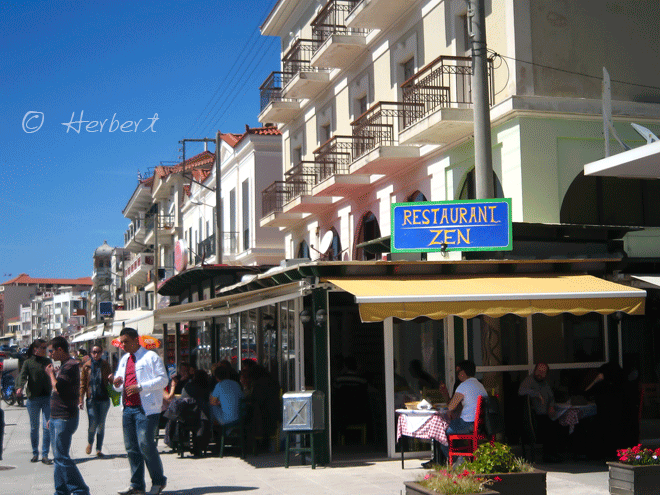May 31, 2010
Hindu pilgrims at Varanasi, Uttar Pradesh, India

Location: Varanasi, Uttar Pradesh, India (25° 16′ 55.2″ N, 82° 57′ 22.68″ E)
Date: 29 September 2005; 7.55am
Camera: Canon 300D with kit lens
Varanasi is one of those magical places on Earth that one feels the influence of religions on mankind. Apart from its array of fabulous architecture, the city is always full of devoted Hindu pilgrims, who perform amazing rites such as bathing and drinking the water of Ganges River. One has to have the utmost of faith and belief to do so as the river is polluted with all sorts of stuff. To me, acts like this (and those of devoted Tibetans prostrating on all fours at sacred temples and prostrating/walking to holy places) are just some of the mysteries and sacrifices that religious faiths can extract from devoted practitioners. Though I have no religious beliefs, such devotion always inspires my unreserved respect.
May 27, 2010
Arc de Triomphe de l'Etoile, the triumphant arch of Paris
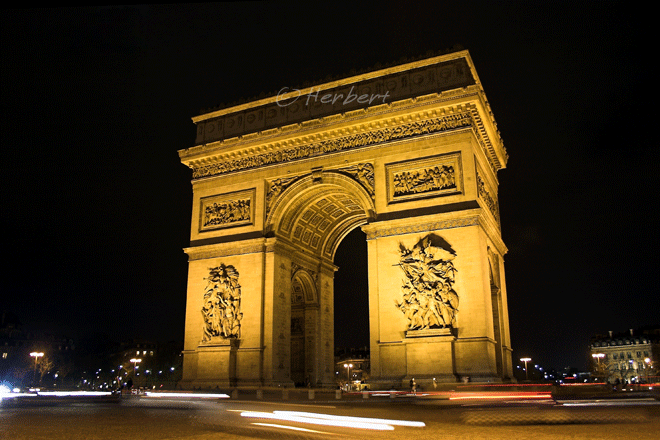
Location: Arc de Triomphe de l'Etoile, Paris, France, (48° 52′ 25.68″ N, 2° 17′ 42″ E)
Date: 2 March 2006; 9.30pm
Camera: Canon 300D with Sigma 70-200/f2.8
The Arc de Triomphe de l'Etoile is one of the most famous monuments in Paris (and Paris is full of monuments). It stands on a busy roundabout in the heart of Paris with 12 avenues leading to it. It is the world's largest triumphal arch, built by Napoleon to honor those who fought for France, particularly those during the Napoleonic Wars. Subsequently the Tomb of the Unknown Soldier was added underneath the Arch after WW1. The Tomb is sheltered and an eternal flame, which is rekindled every evening at 6.30pm commemorates the fallen of the two World Wars. The Arch is an impressive sight with beautiful carvings on its walls; these were added at different times. One can access to the roof of the Arch (admission fee required) for a spectacular panorama of Paris. Together with the Eiffel Tower and Louvre, it is one of the “must-see” of Paris.
May 24, 2010
One of China’s gem, Jiuzhaigou in Sichuan
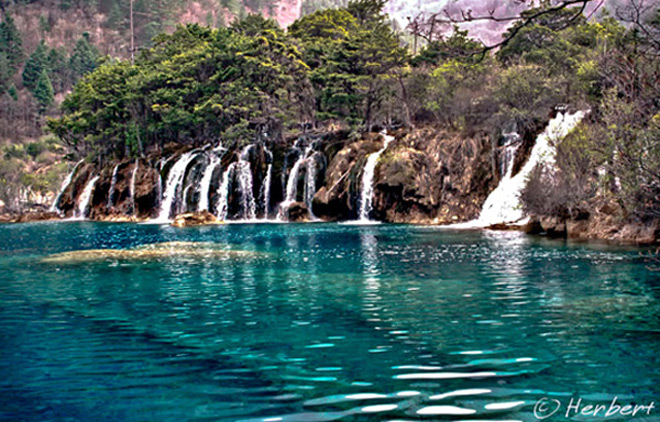
Location: Jiuzhaigou, 九寨沟, Sichuan, China (33° 13′ 0″ N, 103° 55′ 0″ E)
Date: 3 May 1999; 9.15am
Camera: (analogue) Canon 500N with negatives and scanned
Jiuzhaigou is one of the most famous and popular tourist destinations in China to foreigners; the other is of course including Beijing’s Great Wall and Forbidden City. It is a nature reserve, well-known for its beautiful and colourful- blue, green and turquoise- lakes and waterfalls. The reserve’s reputation was enhanced after being featured in the Chinese sword-fighting movie “Heroes” starring Jet Li. The area derived its name from the 9 Tibetan villages along its length- “Jiuzhaigou” meaning Nine Village Valley. The lakes are every clear- some of them are visible to great depths. Its variety of colours is due to carbonate deposits, different residues, reflections of the surroundings as well as the different depths. Visitors to the reserve have to pay a hefty entrance fee of 220 RMB plus 90 RMB for the park bus which operates on a hop-on/hop-off basis. One used to be able to stay inside the reserve and walk around the lakes later in the day when all the tourists have left; but this is now forbidden. The best time to enjoy the beauty of this place is during the autumn months, which is also the busiest. Despite the high entrance fee and (now) blatant commercialization of the reserve, it is still a fantastically beautiful place that should be on the agenda of anyone visiting China.
May 22, 2010
Lausanne Cathedral, Switzerland’s foremost Gothic building

Location: Lausanne Cathedral, Switzerland (46.52256° N, 6.635249° E)
Date: 15 March 2006; 8.15am
Camera: Canon 300D with kit lens
Lausanne, the home of the International Olympic Council is also the home of one of the most beautiful Gothic structure in Switzerland, the Lausanne Cathedral. Construction of the cathedral began in 1175 and in 1275 it was consecrated by Pope Gregory X. However till today, it remains unfinished- restoration is still going on. The interior of the cathedral is relatively austere, with only some choir stalls, a huge pipe organ and a beautiful rose window. The huge Gothic rose window is the most noticeable structure of the whole cathedral, though its towers and spires are also imposing and visible from a distance.
May 18, 2010
Mackinnon Pass, the highest point of the Milford Track, New Zealand
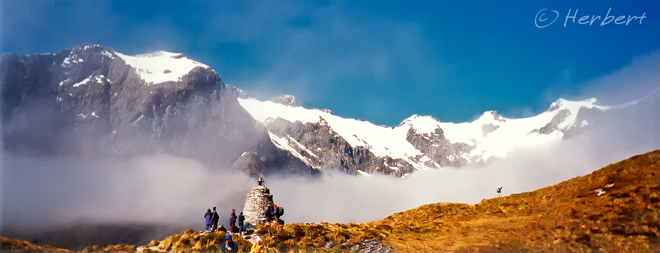
Location: Mackinnon Pass, Milford Track, South Island, New Zealand (44°48'7"S 167°46'13"E)
Date: 20 December 1996; 10.20am
Camera: (analogue) Canon EOS 500N on negatives and scanned
Milford Track is one of the most popular trails in NZ, popularly referred to as “The Finest Walk in the World”. It is 53.5km long and has some beautiful landscape along the trail of glaciated alpine mountains and lakes, waterfalls, rainforests and wetlands. The trail finishes at the Milford Sound, where trekkers will have to take a ferry to cross the sound. The peak season for walking the trail is in the summer months when access is highly regulated. Trekkers must complete the train in 4 days (and 4 days only, nothing more or less) in one direction. No camping is allowed- so trekkers must stay at the huts along the trail. The huts have bunks and supply of gas and water; trekkers have to bring their own sleeping bags, food and cooking utensils. A maximum of 90 trekkers can start on the trail each day and these 90 people must move on to the next hut every day; so one always see the same 89 other trekkers for the 4 day duration. The walk can be done easily independently as it is clearly marked. It is so popular during the summer months that it is not uncommon to have to book a place 12 months ahead! Milford Track is very spectacular especially after some rains with waterfalls everywhere as rainwater trails down the vertical cliffs.
May 12, 2010
The ancient Tea Horse Trail of China
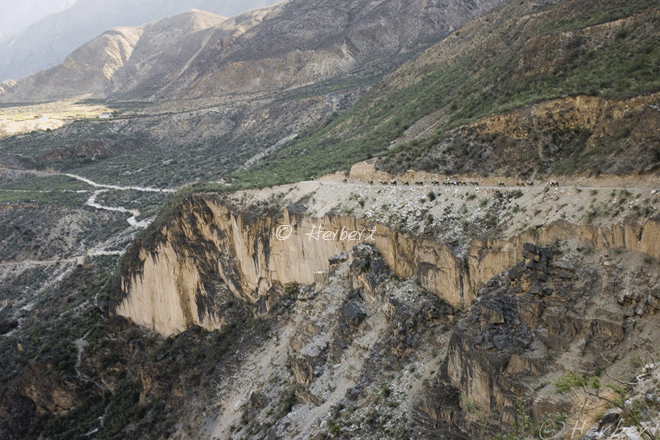
Location: Horse caravan on the way to Chawalong, Tibet, China ( 28° 30′ 0″ N, 98° 24′ 0″ E)
Date: 4 May 2005; 10.45am
Camera: Canon 300D with kit kens
There is a good article about the ancient Tea Horse Trail in the latest issue of the National Geographic magazine (the article has a factual error- Budweiser is never available everywhere in China. Perhaps the author is trying to make the majority of the readers, who are American feel more “at home”). The Tea Horse Trail was an ancient route used by traders to transport much needed and appreciated tea to Tibet and in return bring the famed Tibetan horses back to China. It was a series of routes, crossing over high mountain passes from Sichuan and Yunnan into (then) Tibet. It was amazing because of the hardship and amazing terrains the routes passed. The article focused on the “Middle route” which is the most difficult as it crosses some very high passes and can only be accomplished by human carrying the compressed tea bricks. Some of the other routes are no less exciting due to the deep gorges and perilous environment they passed. Though the majority of such routes are no longer in use, some are still very important as there are the only connections for people along them. An example is the Tea Horse Trail along the Nujiang Gorge (or Salween River) from Bingzhongluo in northwest Yunnan into the south of Tibet (see these articles for a description of the route/trek and an alternate entry into Tibet). The route is perilously narrow, snaking along the river and is susceptible to frequent landslides, so unsuitable for vehicles. There are many remote villages along the route and their needs for necessities such as sugar and salt (as well as beer) can only be brought in by horse caravans. The scenery along this section of the Tea Horse Trail is simply breathtaking where human and animals are simply dwarfed by the immensity and majesty of the mountains and deep gorges (see photo). This is a part of China that very few people have seen and is changing rapidly, just like the rest of the country. This photo and journey description was in mid-2005. My friend, Michael had already reported in late 2007 that a section of the route in Yunnan is now passable to 4WD’s.
May 10, 2010
A racist eatery on Samos Island, Greece
Location: Samos town on Samos Island, Greece (37° 44′ 0″ N, 26° 50′ 0″ E)
Date: 3 April 2010; 2.15pm
Camera: Canon IXUS iZoom
Samos is a small Greek island in the Aegean Sea, popular as a holiday destinations especially for day trippers from Turkey. I find Greeks to be generally friendly, though far from the friendliness of their neighbour, Turkey. However I had the worst racist experience there in all my travels and stay overseas, in a small restaurant/cafe named Restaurant Zen (picture). I was there with my travel companion, also Chinese, during the Easter weekend. We went there on the first evening around 7pm when the restaurant was quite busy but have a couple of empty tables still. We asked if there are any empty tables and we were told there were none. Well, we did not think too much about it as we thought the empty tables may have been reserved. We went back there the next afternoon for lunch, around 1.30pm. This time, the restaurant was not as busy with at least 3-4 empty tables. Again we were told by the same waitress that there are no tables available. She took a look at us and we were told in a manner and tone that was not really pleasant, something like “No, no, no table, go, go” (we also recalled the similar tone that she spoke to us the previous night). We were a little annoyed and puzzled as there were obviously empty tables about. Anyway we walked around the waterfront a bit to scout for other lunch places; the next thing we noticed 3 Greeks went to the restaurant and were shown to an empty table- the same empty ones when we went in earlier. Something about the way the guests went to the restaurant and the way they were shown the table indicated to us that they just walked in without reservation. Now we may be over-reacting but both of us had traveled and lived in different societies enough to recognize racial discrimination when it happens. The whole experience left a really bad taste in our mouth and marred our perceptions of Greeks.
May 8, 2010
Top 100 Travel Photography Blogs
This blog have been listed as one of the "Top 100 Travel Photography Blogs" recently in the Photography Colleges site (item 29).
A prayer for Thailand
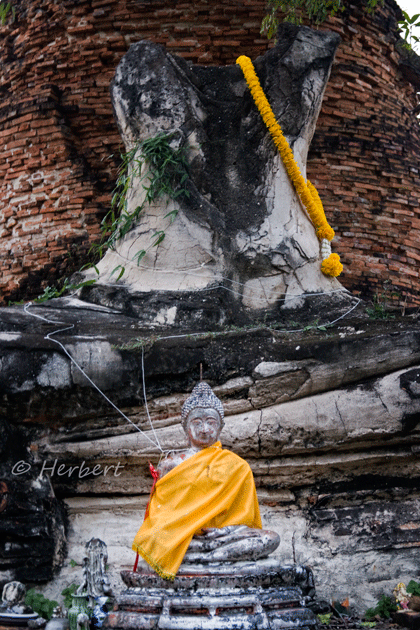
Location: Ayutthaya, Thailand (14°22'14.81"N 100°33'38.23"E)
Date: 27 October 2009, 3.25pm
Camera: Canon 400D with Sigma 17-70/f2.8-4.5
Tourism is one of the biggest foreign income earners for Thailand. However it is taking a beating at the moment due to the Red Shirt protest in Bangkok. Tourism is not the only victim, businesses in general is also suffering tremendously. Whilst I sympathize with the objectives of the Red Shirts, at the back of my mind, I am wondering if the protesters are being taken for a ride by Thaksin (the former and fugitive Prime Ministers) and his cronies. I, personally, do not have any sympathy for him. It is rather sobering that another neighbour country that is also close to my heart is going through such a rough patch so soon after a situation in China previously. I can only wish them luck in resolving the problem very soon.
May 6, 2010
Wuxuhai on an autumn morning, Sichuan, China

Location: WuxuHai 伍须海, Jiulong, Sichuan, China (30° 3′ 0″ N, 101° 58′ 0″ E)
Date: 18 October 2006, 7.25am
Camera: Canon 300D with kit lens
China is one of my favorite destinations as she has such a variety of people (surprise!!), cultures and landscapes that I kept going back there again and again, often to the same places. One of the provinces that have a lot to offer any travellers is Sichuan. It is one of the bigger province of China, and is a microcosm of China in its diversity of people and landscape. Apart from some of the most well-known destinations in China such as Jiuzhaighou, EmeiShan, Leshan and so on, there are also many hidden gems, yet to be discovered by the mainstream tourists. One example is the area around the Jiulong County. This county is a little remote and is inhabited mainly by Tibetan farmers. It has several beautiful alpine lakes that can only be accessed by trekking- this may have changed by now as when I was there few years ago, roads are already being cut. Wuxuhai is one of these lakes.
















